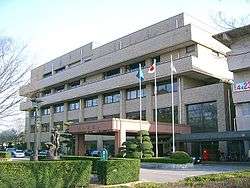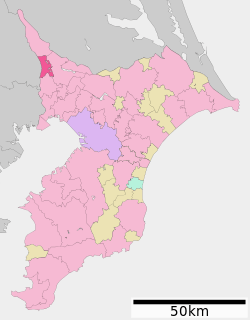Nagareyama
Nagareyama (流山市, Nagareyama-shi) is a city located in Chiba Prefecture, Japan.
Nagareyama 流山市 | |
|---|---|
 Nagareyama City Hall | |
 Flag  Seal | |
 Location of Nagareyama in Chiba Prefecture | |
 Nagareyama | |
| Coordinates: 35°51′22.7″N 139°54′10.3″E | |
| Country | Japan |
| Region | Kantō |
| Prefecture | Chiba Prefecture |
| Government | |
| • Mayor | Yoshiharu Izaki (Ind; since May 2003) |
| Area | |
| • Total | 35.28 km2 (13.62 sq mi) |
| Population (2019) | |
| • Total | 192,443 |
| • Density | 5,449/km2 (14,110/sq mi) |
| Time zone | UTC+9 (Japan Standard Time) |
| -Tree | Japanese Box |
| - Flower | Rhododendron |
| Phone number | 04-7158-1111 |
| Address | 1-1-1, Heiwadai, Nagareyama-shi, Chiba-ken 270-0192 |
| Website | http://www.city.nagareyama.chiba.jp/ |
History
During the Edo period, Nagareyama was a river port on the Edogawa River. After the Meiji Restoration, Nagareyama Town was created in Inba District, Chiba Prefecture on April 1, 1889. On January 1, 1952, it merged with neighboring Edogawa Town to form a new Nagareyama Town. Nagareyama became a city on January 1, 1967.
Geography
Nagareyama is located in the far northwestern corner of Chiba Prefecture, bordered by the Edogawa River to the west. The total area is 35.28 km2 (13.62 sq mi).
Neighboring municipalities
- Chiba Prefecture
- Matsudo
- Kashiwa
- Noda
- Saitama Prefecture
Population
As of 2019, the city has an estimated population of 192,443, and a population density of 5,449 persons per km².
In early 2000 CE, Nagareyama had an exodus of young people. Men and women are usually occupied with jobs during daytime. However, Nagareyama lets women pursue their career while their children spend time in childcare facilities. In 2003, mayor Yoshiharu Izaki made investments in childcare centers a primary focus of the city's government. It includes a transit service at Nagareyama-centralpark Station where parents can drop off their children on their way to work. The children are shuttled with buses to daycare centers. Senior people of the local community help with shuttling the children. Many parents say this transit service was one of the biggest reasons for them to move to Nagareyama. The result is over the past 13 years (2006-2019 CE) the population has grown by more than 20%. 85% of children have more than one sibling. Young children are expected to outnumber elderly in the future. Parents worry less about having more children, because the whole community helps with raising children and parents don't feel isolated. People in Nagareyama have a strong local network, with a friendly neighborhood. People share information and concerns. There are also many local events and community spaces where children and elderly interact. There's a summer camp for children while their parents work during holidays. These family friendly approaches lured young working parents from Tokyo to Nagareyama.[1]
Economy
Nagareyama is a regional commercial center and a commuter town for nearby Chiba and Tokyo. The city is also noted for its production of mirin, a sweetened sake used for cooking.
Education
Transportation
Railway
- Ryūtetsu - Nagareyama Line
- Tobu Railway - Tobu Noda Line
- East Japan Railway Company (JR East) - Musashino Line
- Metropolitan Intercity Railway Company - Tsukuba Express
Highway
International relations
Twin towns — Sister cities
Nagareyama is twinned with:



Noted people from Nagareyama
- Hidekazu Otani – professional soccer player
- Yukiko Sumiyoshi – manga artist
In fiction
- The fictional Nagarekawa of Locodol is based on Nagareyama. After the anime's release, the characters have become the city's official tourism concierge.
References
- "Japan Baby Boom: City's policies turn around population decline". TRT World. 2019-09-14. Retrieved 2019-12-28.
External links
| Wikimedia Commons has media related to Nagareyama, Chiba. |
- Official Website (in Japanese)